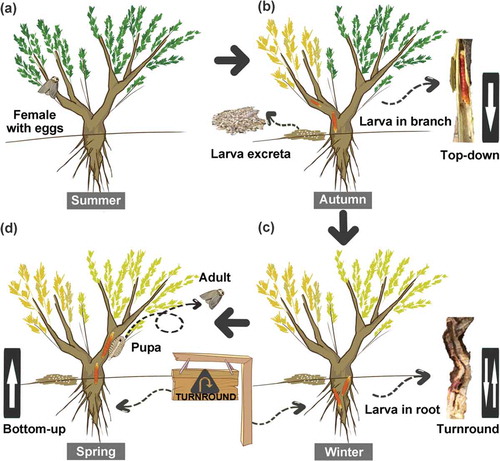ABSTRACT
Introduction:Understanding the trophic interactions between plants and herbivorous insects is essential for managing the ecosystem health and sustainability in the context of climate change and anthropogenic disturbance. The Tamarix chinensis is a foundation plant species of salt marshes in northern China, which provides a variety of ecological functions and services in coastal ecosystems such as withstanding storm tide, conserving biodiversity, and preventing shoreline erosion. Outcomes: However, through long-term field observations, for the first time, we found that the health of this population has been suffering from the potential outbreak of a novel wood-borer insect (Zeuzera leuconotum Butler) under multiple stresses, contributing substantially to the degradation of the coastal salt marshes. Discussion and Conclusion: Therefore, there is urgent need and great significance to investigate the potential impact of this herbivorous wood-borer insects on health and sustainability of plant community in coastal ecosystems for in-depth understanding its degradation mechanisms.
1. The foundation species (Tamarix chinensis) of coastal salt marshes in northern China is undergoing degradation with observable die-offs, which may be due to multiple abiotic and biotic stresses, especially the potential outbreak of a herbivorous wood-borer (Zeuzera leuconotum Butler).
Accelerating population decline of this woody plant species is inevitably influenced by the stability, health, and services of coastal ecosystems as they (primary producers) play fundamental roles in regulating the community structure and ecosystem functioning (Cui et al., Citation2010; Liu, Rong, and Zhao Citation2017; Li et al. Citation2019; Xie et al., Citation2020). The wood-borer insect is a native insect that feeds on a relative wide range of host plants. Previous observations have reported that this species could feed on the stem of many woody plants in terrestrial ecosystems, such as Fraxinus chinensis Roxb., Robinia pseudoacacia Linn., Salix babylonica Linn (Liu et al. Citation2010). It is the first time we found that T. chinensis in coastal ecosystems as a new host plant for this insect. Thus, this insect species may expand its range from the terrestrial ecosystems to the coastal ecosystems under the disturbance of human activities and climate changes, such as land-use change, soil pollution, drought (Batzer and Wu Citation2020). Moreover, the decrease of natural enemies driven by the above-mentioned global changes may also be an important reason for the insect outbreak (Maron, Harrison, and Greaves Citation2001;. Boggs Citation2016).
See Photo 1.1 Approximately 70% of the host plants in the Yellow River Delta National Nature Reserve (YRDNNR, including Yellow river estuary, Dawenliu and Yiqian’er management stations) was infected by the wood-borer insect (personal observations). The heavy die-offs of the host plant are located at the core zone of the high salt marshes in the Yellow river estuary management station in YRDNNR (37°45.80′ N ~ 37°45.91′ N, 119°09.46′ E~119°11.32′ E). Photo credit: Z. Ning.
Photo 1.1 The die-offs of the foundation species (Tamarix chinensis) in the Yellow River Delta, an important salt marsh wetland in northern China

See Photo 1.2 It is likely that these stems will become completely dead if they are exploited by the wood-borer (see stems with yellow leaves in photos). The cluster in dotted circles of the photos is the excreta of the wood-borer generating from its tunneling activity. Photo credit: Z. Ning and C. Chen.
Photo 1.2 The growth and health of the foundation plant species (Tamarix chinensis) is heavily disturbed by an insect herbivore (Zeuzera leuconotum Butler), which mainly tunnels and consumes the stem of the plant in its larval stage, in particular with the young stem
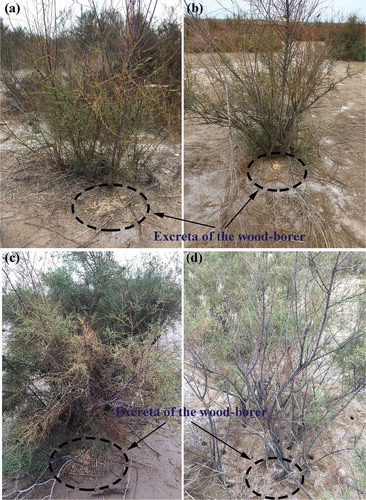
2. The caterpillar of the wood-borer makes a hole and feeds inside plant shoots and roots that heavily damage the xylem tissue of the foundation plant species thus profoundly affects the ecosystem health of coastal salt marshes (See photo 2.1 and 2.2).
Photo 2.1 Tunnel networks in shoots (photos (a) and (b)) and roots (photo (c) and (d)) of the plant Tamarix chinensis excavated by the wood-borer insect. Photo credit: Z. Ning and X. Ma
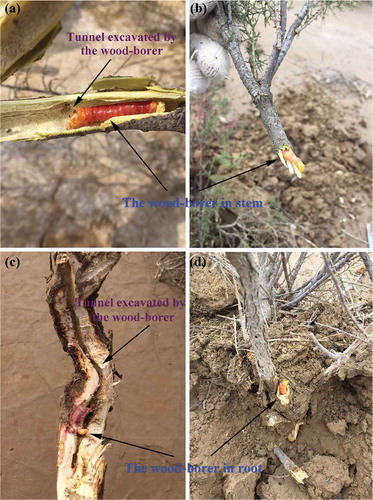
Photo 3.1 Field photos showing the different developmental stages of the herbivorous wood-borer insect
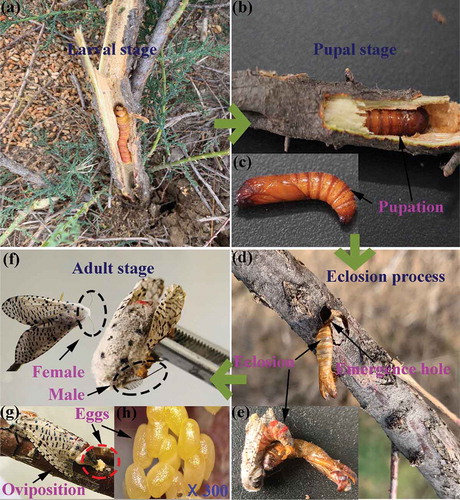
Photo 2.2 The larva of the wood-borer insect under the microscope. Photos (a) and (b) represent the panorama of the wood-borer, and photo (c) is the mouthparts of this caterpillar (magnified 100 times). Photo credit: Z. H. Ning
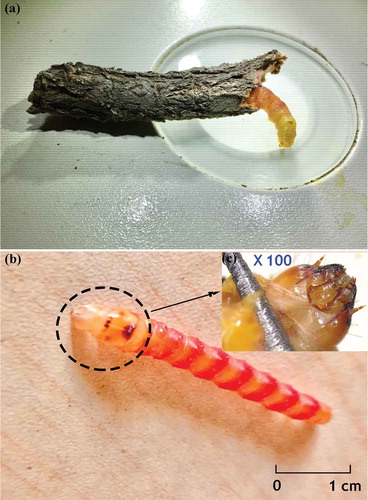
3. The developmental processes of the wood-borer insect in its life cycle and the mechanisms of damaging the healthy plant T. chinensis.
See Photo 3.1 Clockwise from top left are the field photographs that represent the larva stage (a), pupal stage (b, c), eclosion process (d, e), and the adult stage (f–h) of the wood-borer, respectively. The caterpillar feeds inside of the stems and roots of the host plant (Tamarix chinensis) throughout the larva stage, and excavates a tunnel network for their movement. The larva approximately has five instars, and exuviates at night, pupates at 5rd instar old larvae, pupation time needs about 10–14 days. During its pupation, the fifth instar caterpillar forms a pupal chamber inside of the tunnel using its excreta and sawdust, and bites an oval emergence hole, while only leaves a thin layer of bark membrane as the cover of the hole. When the pupal development finishes, the adult emerges and flies out from the emergence hole with the assist of sea wind to some extent. The sex of the adult can be distinguished by the shapes of its antennae. The thread-like antenna is a female and the comb-like antenna represents a male (see the black dotted circles in photo (f)). During the adult stage, the females and males usually mate at night. Then, the fertilized females oviposit eggs in the crack of the plant bark (see the red dotted circle in the photo (g); photo (h) shows the details of the eggs under the microscope (magnified 300 times)). Generally, the life span of adults is approximately 7–10 days. Photo credit: Z. Ning and C. Chen.
See Figure 3.2 This insect only has one generation per year. The hatched larvae from eggs oviposited by adult females infecting the stem, which caused the death of plants during summer (a) and autumn (b); the caterpillar moved to the roots of plant for overwintering when they reached the final stage of larva (c); these caterpillars reactivate to feeding on xylem tissues from roots to another shoots of plants until the larvae were fully developed, and pupated inside of the plant stem until they developed into the adult (d). The stem with yellow leaves indicates that the health of the plant is heavily infested by the wood-borer. The arrows represent the main direction of the larva movement in different seasons.
Conclusions
Woody plant T. chinensis, as the foundational species in the salt marshes of northern China, plays a key role in maintaining the stability and functioning of coastal ecosystems. Constantly high pressure of the novel wood-borer insect herbivory, potentially caused by climate changes and anthropogenic activities, strongly affects the population dynamics of this foundation species, thus seriously threatening the health and services of coastal ecosystems. This first report suggests that the integrated pest management of wood-borer insect is urgently needed to mitigate the negative impact of insect outbreaks. Future studies should further investigate the mechanisms of the novel wood-borer insect outbreaks underlying multiple abiotic and biotic stresses driven by the dual pressures of climate changes (e.g., drought, heat wave) and anthropogenic activities (e.g., land-use change, pesticide abuse), in order to better maintain the health and sustainability of the coastal salt marsh ecosystems.
Disclosure statement
The authors declare that all of the photographs are original and they have no conflict of interest.
Additional information
Funding
References
- Batzer, D. P., and H. Wu. 2020. “Ecology of Terrestrial Arthropods in Freshwater Wetlands.” Annual Review of Entomology 65 (1): 101–6. doi:10.1146/annurev-ento-011019-024902.
- Boggs, C. L. 2016. “The Fingerprints of Global Climate Change on Insect Populations.” Current Opinion in Insect Science 17: 69–73. doi:10.1016/j.cois.2016.07.004.
- Cui, B., Q. Yang, K. Zhang, X. Zhao, and Z. You. 2010. “Responses of Saltcedar (Tamarix Chinensis) to Water Table Depth and Soil Salinity in the Yellow River Delta, China.” Plant Ecology 209 (2): 279–290. doi:10.1007/s11258-010-9723-z.
- Li, X., J. Xia, X. Zhao, and Y. Chen. 2019. “Effects of Planting Tamarix Chinensis on Shallow Soil Water and Salt Content under Different Groundwater Depths in the Yellow River Delta.” Geoderma 335: 104–111. doi:10.1016/j.geoderma.2018.08.017.
- Liu, J., Q. Rong, and Y. Zhao. 2017. “Variations in Soil Nutrients and Salinity Caused by Tamarisk in the Coastal Wetland of the Laizhou Bay, China.” Ecosphere 8 (2): e01672. doi:10.1002/ecs2.1672.
- Liu, L., Q. Liu, X. Liu, C. Li, Y. Zhang, and C. Ma. 2010. “Studies on Selection Behavior for Transferring Host of Zeuzera Leuconotum Butler Larvae (In Chinese with English Abstract).” Journal of Tianjin Normal University (Natural Science Edition) 30 (2): 73–77.
- Maron, J. L., S. Harrison, and M. Greaves. 2001. “Origin of an Insect Outbreak: Escape in Space or Time from Natural Enemies?” Oecologia 126 (4): 595–602. doi:10.1007/s004420000558.
- Xie, L., B. Wang, M. Xin, Q. Wei, W. Wang, X. He, J. Wang, X. Shi, and X. Sun. 2020. “Impacts of Coppicing on Tamarix Chinensis Growth and Carbon Stocks in Coastal Wetlands in Northern China.” Ecological Engineering 147: 105760. doi:10.1016/j.ecoleng.2020.105760.

